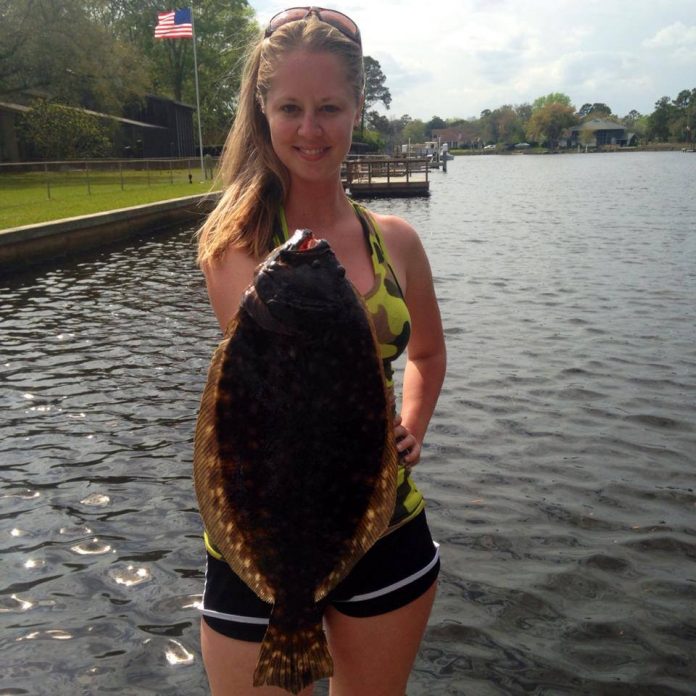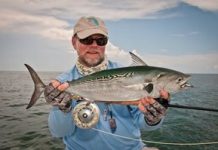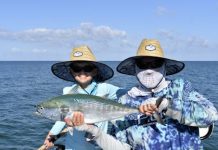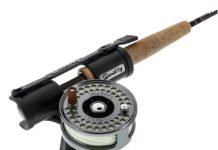By CAPT. PAT DAMICO. CapMel.Com Fly Fishing Editor
One of my first fly fishing experiences in the Tampa Bay area was fishing a fresh water river that empties into the Bay. It was mid winter and low saltwater temperatures had many of our warmer water targets now in more comfortable brackish environments. My companion, Bob Finck, suggested this trip and he was right on the money. We caught snook, reds and large jacks from my flats boat where occasionally a fly could be cast to either shore. This was twelve years ago, but the experience is repeated every year under cold weather conditions.
We have a number of rivers in my area and each has its own characteristics. Review some maps and charts of your destination. A computer search on Google Earth will give you some satellite views that you can print. USGS website will have current water levels as well as flow rates and water temperature. Your initial trip should be at a higher tide stage. Visit local bait shops. One owner directed me to the closest public ramp which was on a small rarely used back road. As I entered the main part of the river, I noticed a research vessel. Always interested in public relations, a short visit with them gave me a wealth of good information. The researchers pointed to several mangrove points where I could find snook on an incoming tide. I was also told how far I could go upriver before I would find fresh water. A few shallow areas that could be a navigation problem at low tide were also brought to my attention. I spent about five hours there and was rewarded with eight snook and two reds. All were taken with my eight weight fly rod while exploring my new playground. I made a lot of entries in my log that evening and had many good reference points for my next trip. My next visit would expand my search using these initial notes.
Arriving when the mangroves are beginning to flood not only positions the fish in close to the shoreline but makes getting into bays and back water areas easier. I have found an incoming tide to be just as productive as an outgoing tide on most river systems.
The water in most rivers will be stained from tannin. The white and more brightly colored flies that I often use in open water stand out like a beacon in this tea colored water and I have modified my fly colors to suite this new environment. If you look at baitfish there, they will have a predominantly brown/gold appearance. Since I prefer synthetic materials, baitfish patterns will have bodies that give a gold sheen with some brown on top. Polarfiber minnows in sizes 1 to 4 are my favorite for probing the shoreline. Choose flies that push water. Muddler Minnow variations are a good choice. The closer you fish to the mangrove roots, the more effective will be your presentation. A weedguard will help when you overcast and hit a mangrove branch. Just tease the fly over the branch by retrieving it slowly. A quick short strip as soon as the fly hits the water will often trigger a strike. Most fish will be found in the shade of the trees; accuracy in casting is imperative. Synthetic material is buoyant. Put some weighted wire around the hook before starting the fly pattern, a heavier hook will also help. My Bead Butt Baitfish with a gold bead is a river favorite.
This time of year smaller snook are the norm. A seven or eight weight fly rod with a twenty-five pound shock tippet will usually be adequate. A shorter leader is helpful when fishing mangrove shorelines allowing you to tuck flies into small targets that hold fish. Concentrate on where you want your fly to land, not on the surrounding mangroves. In confined space, I find TFO’s, TiCrX, seven and a half foot eight weight rod an improvement over the standard nine foot rods. If a large fish wants to fight, this rod will tame him.
A pole is always the stealthiest way to fish shallow water. If you fish the shorelines and are alone, a bow-mounted electric is very effective. Stay as far as your casting ability will allow as you parallel the bank. Use the wind and tide in your favor. If your first drift was too quick, do another one to make sure you haven’t missed anything.
It would be impossible to explore without a good depth finder. I found some water that was over twenty feet deep on the outside bends which are always deeper. Lines of crab traps usually will mark deeper water. Your temperature gage will also help you find fish seeking warmer water. As always, be familiar with tides so you don’t get stuck in the shallows. The change from mangroves to cattails usually shows fresh water is present. A seven foot ‘gator, patrolling the shoreline, let me know that I was invading his fresh water home.
Carefully check any bridges. The deep water around the abutments will harbor larger snook and jacks that feed voraciously when the tide is moving. Heavier tackle will be needed here to prevent lost fish.
If you want to extend your fly fishing into the colder weather, find warmer water and follow the normal movements of fish. I have spent many weekdays as the only boat in a lot of these areas enjoying some fabulous fishing.
Capt. Pat Damico, a FFF certified fly casting instructor, guides in lower Tampa Bay as well as surrounding water offering fly and light tackle trips. He can be reached at 727-504-8649, or through his website www.captpat.com where more information is available.
- Captain’s Corner:Pat Damico - June 25, 2019
- Flat water makes seeing tarpon easier - May 17, 2017
- Warm rivers holding plenty of targets for fly fishermen - February 16, 2017












